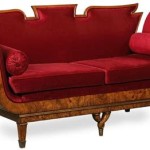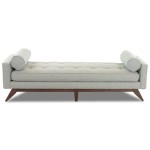1940s Sofa Styles
The 1940s marked a period of significant transition in furniture design, influenced by the constraints and subsequent aftermath of World War II. Materials were rationed, and manufacturing focused on utility and durability. This practicality, however, didn't preclude style. The decade witnessed the emergence of distinct sofa styles that blended function with evolving aesthetic preferences.
Early 1940s sofas often retained elements of the preceding decade's streamlined Art Deco movement. These pieces featured gentle curves, rolled arms, and sometimes incorporated wood trim. However, the ornamentation became more subdued, reflecting the wartime emphasis on simplicity. Upholstery fabrics were typically durable and practical, often in solid colors or simple patterns.
The war years also saw the rise of the "Utility" sofa. This style prioritized function over elaborate design. Utility sofas were generally compact, with straight lines and minimal embellishments. They were designed for smaller spaces and often featured loose cushions for versatility and ease of cleaning. The focus was on affordability and practicality, making them suitable for the average household during a time of economic constraint.
As the war ended and prosperity returned, sofa styles began to evolve. The late 1940s witnessed the emergence of what is often considered the precursor to the Mid-Century Modern style. Sofas began to incorporate more organic shapes, influenced by the burgeoning biomorphism movement in design. Curved backrests, tapered legs, and integrated armrests became characteristic features. The use of wood also became more prominent, often showcasing the natural grain and texture.
The post-war period also saw a renewed interest in comfort and luxury. Sofas became larger and more plush, reflecting a desire for relaxation and leisure after years of austerity. Deep seating, button tufting, and luxurious fabrics like velvet and mohair gained popularity. This trend towards comfort and elegance marked a departure from the strict utilitarianism of the war years.
Sectional sofas also began to appear in the late 1940s, offering greater flexibility in arranging furniture within a living space. This modular design reflected the changing needs of families and the growing popularity of open-plan living areas. Sectionals allowed for customized configurations and could be adapted to suit different room sizes and layouts.
The influence of Hollywood glamour also played a role in shaping 1940s sofa styles. The elegant and sophisticated aesthetic of film sets seeped into furniture design, leading to the creation of pieces with a more dramatic flair. Tufted backrests, scrolled arms, and luxurious fabrics like satin and damask contributed to this glamorous look.
Color palettes in 1940s sofas varied, but certain trends emerged. Early in the decade, muted tones and earth colors were prevalent, reflecting the wartime focus on practicality and camouflage. As the war ended, brighter colors and bolder patterns began to appear, expressing a renewed sense of optimism and prosperity. Jewel tones like emerald green, sapphire blue, and ruby red became increasingly popular.
Materials used in 1940s sofa construction also reflected the era's constraints and evolving trends. During the war years, materials like metal and wood were often scarce, leading to the use of alternative materials like fiberboard and plywood. As resources became more readily available, hardwood frames and high-quality springs became more common, contributing to the durability and comfort of these pieces.
Identifying authentic 1940s sofas requires careful examination of several key features. Construction techniques, materials used, and stylistic elements can all provide clues to a sofa's age and origin. Consulting vintage furniture guides and seeking expert advice can be helpful in verifying the authenticity of a piece.
The legacy of 1940s sofa styles continues to influence contemporary furniture design. The clean lines, functional forms, and emphasis on comfort that characterized many sofas of this era can be seen in modern interpretations of mid-century and contemporary styles. The 1940s represent a significant period in furniture history, demonstrating how design can adapt to changing social, economic, and aesthetic influences.
The resurgence of interest in vintage and mid-century modern furniture has led to a renewed appreciation for 1940s sofa styles. These pieces offer a unique blend of practicality, comfort, and historical significance, making them a desirable addition to many homes today. Whether restored to their original condition or re-upholstered in contemporary fabrics, 1940s sofas continue to provide both aesthetic appeal and functional seating solutions.

Circa 1940 S French Olive Green Mohair Sofa Vintique

Art Deco Sofa By William Ulrich 1940s For At Pamono

1940s French Provincial Style Sofa In Retro Velvet Off The Beaten Track Warehouse Dc

1940 S Vintage Victorian Couch Ruby Red Silk In 2024 Rustic Style Sofas

Gugliemo Ulrich Art Deco Italian Velvet Curved Sofa 1940s At 1stdibs Sofas 1940 S Style Couch

Danish 1940s Art Deco Banana Form Curved Sofa In The Style Of Fritz Hansen Jenmod

1940s Italian Sycamore Sofa For At 1stdibs Couch Sofas

1940s Burgundy Sofa And Chair Sofas Red Kitchen Decor Art Deco Living Room

Couches For 1940s 1950s Or 1960s Living Rooms Upload Photos Of Your Sofa Retro Renovation Vintage Couch

Hide A Bed Sofas From The 40s 50s 60s 70s See 50 Vintage Styles Americana








